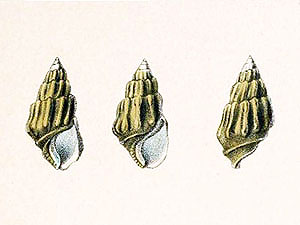Lake Petea Snail (Microcolpia parreyssii)
The Lake Petea Snail is one of the few species
in which we can trace the exact course of their extinction.
***
The species was described in 1847, it was restricted to a single relict site, Lake Pețea, a thermal lake with a water temperature of around 42 °C near the town of Oradea in north-western Romania.
The lake is situated above a rich geothermal aquifer, which is known since ancient times, the thermal water has been used to heat a public bath and several houses in the area. It is home to several endemic plant- and animal forms and was declared a nature reserve in 1932. With the beginning of the 2000s the site was found to be heavily polluted with litter; in 2011, the thermal underwater spring suddenly ceased its activity, resulting in an abrupt reduction of the water level and the surface area and in 2015, the lake was reduced to a small pond due to the overexploitation of the thermal aquifer.
In an effort to save the Lake Petea Snail from extinction, several individuals were brought into captivity; in the beginning these individuals reproduced but after some time they began to suffer from a high mortality, and the last surviving snails were finally sent to specialists, but without any success – the species is now extinct. [1]
*********************
References:
[1] Ioan Sîrbu; Adrian Gagiu; Ana Maria Benedek: On the brink of extinction: Fate of the Pețea thermal lake (Romania) and its endemic species. Tentacle 21: 34-37. 2013
[2] Thomas A. Neubauer; Mathias Harzhauser; Elisavet Georgopoulou; Claudia Wrozyna: Population bottleneck triggering millenial-scale morphospace shifts in endemic thermal-spring melanopsis. Paleogeography, Paleoclimatology, Paleoecology 414: 116-128. 2014
[3] Ioan Sîrbu; Ana Maria Benedek: Requiem for Melanopsis parreyssii or the anatomy of a new extinction in Romania. Tentacle 24: 26-28. 2016
*********************

Photo from: ‘Thomas A. Neubauer; Mathias Harzhauser; Elisavet Georgopoulou; Claudia Wrozyna: Population bottleneck triggering millenial-scale morphospace shifts in endemic thermal-spring melanopsis. Paleogeography, Paleoclimatology, Paleoecology 414: 116-128. 2014’
(under creative commons license (3.0))
https://creativecommons.org/licenses/by/3.0/
*********************
edited: 17.11.2021


